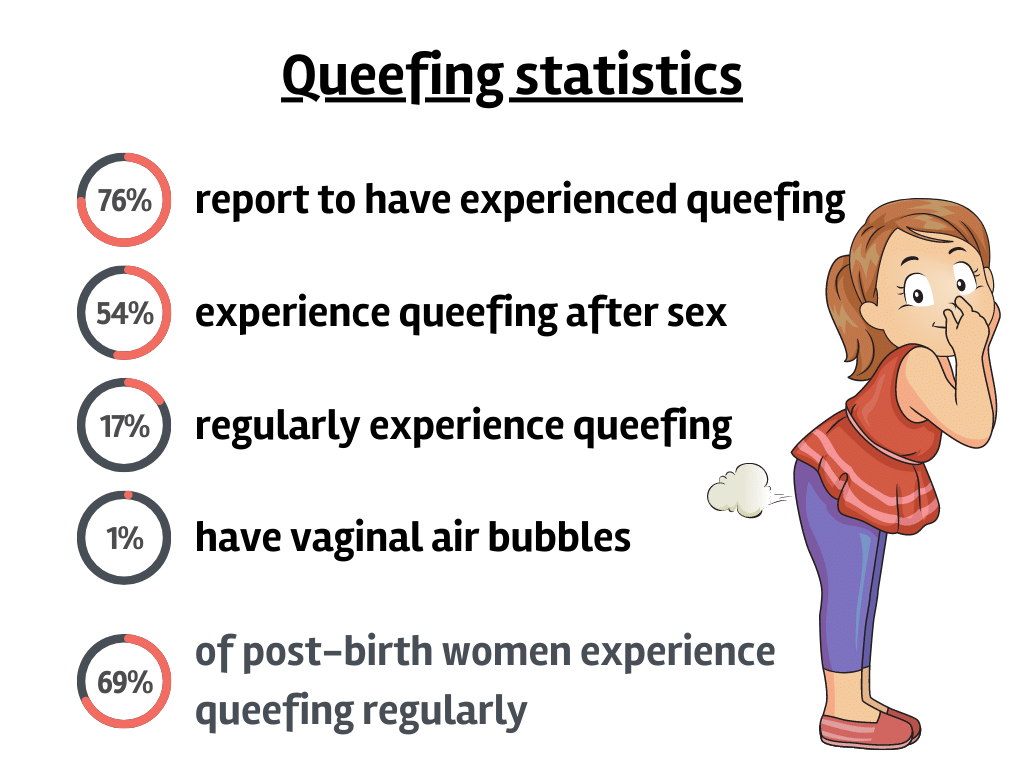![How Common is Queefing [Vaginal Gas Statistics]](https://wp.bedbible.com/wp-content/uploads/2023/04/how-common-is-queefing.jpg)
Queefing, known scientifically as vaginal flatulence, is a natural and harmless event where air is expelled from the vagina, typically producing a noticeable sound. While often a cause of embarrassment, it’s a normal bodily function.
This meta-study delves into its prevalence, drawing on data from 11 scientific studies and 10 public surveys, involving a combined total of 8,749 participants. Through this comprehensive analysis, we aim to shed light on a topic that, despite its commonality, remains seldom discussed in public forums.
Here’s what you’ll find in this report:
- Scientific studies on the prevalence of Vaginal Wind/Noise/Flatulence
- How many women have experienced queefing ever?
- Understanding Vaginal Flatulence
- Factors Influencing the Prevalence of Queefing
- Conclusion
Major Findings
- Between 63% and 89% of women have experienced queefing at least once.
- Regular queefing occurs in 5.5% to 28.9% of the general female population.
- Vaginal air bubbles, which lead to queefing, were found in just 0.96% of examined women.
- Post-sexual intercourse queefing is reported by 54% of women.
- Up to 69% of women who have recently given birth report regular queefing.
- Childbirth, age, and intrapelvic pathology are key factors that influence the occurrence of queefing.

Scientific studies on the prevalence of Vaginal Wind/Noise/Flatulence
Coming through all the scientific articles with information about the prevalence of how common queefing – also called Vaginal Wind, Vaginal Noise, and Vaginal Flatulence in the studies – we find a range:
- 5.5% to 28.9% of women in the general public regularly experience queefing.
- Some studies found that up to 69% of women regularly experience queefing (2.3 times per day on average).
- However, this study collected a non-representative sample of women who had all just given birth. In other words, it can be more safely concluded that on average 69% of women who have just given birth regularly experience queefing 2-3 times per day.
- In a study where scientists scanned 2800 females, they found that only 0.96% of women had vaginal air bubbles (typically leading to vaginal winds).
- Another study found that 54% of women experienced queefing after sex.
| Study | N | Main findings |
|---|---|---|
| J. M. Miranne, T. M. Marek, M. Mete, C. Iglesia (2015). Prevalence and Resolution of Auditory Passage of Vaginal Air in Women With Pelvic Floor Disorders. Obstetrics and gynecology | 110 | • Vaginal wind is common among women with pelvic floor disorders but is not associated with POP. • 69% of women experienced vaginal wind an average of 2.1 times weekly. • Women with vaginal wind were younger than those without vaginal wind. |
| A. Wald (2015). Vaginal Wind and Pelvic Floor Disorders. | 110 | • 110 women were surveyed about their experiences with vaginal wind. • The majority of women reported experiencing vaginal wind at least once in their lifetime. • Vaginal wind was associated with pelvic floor disorders in some women. |
| Jeannine M. Miranne, T. M. Marek, Mihriye Mete, Cheryl B. Iglesia (2014). The Association of Vaginal Wind and Abdominal Striae with Pelvic Organ Prolapse. | 123 | • 132 patients were approached for participation, of which 123 (93%) agreed to participate and 110 (83%) completed study questionnaires. • 76/110 (69%) women experienced vaginal wind an average of 2.3 times per week and this was not statistically significant between groups (p = 0.47). • 99% of women with vaginal wind experienced it during intercourse. |
| Samera F. AlBasri, Hanan AlShomrani (2023). Vaginal wind: A Silent but Common Symptom. Journal of Complementary Medicine Research | 41 | • Vaginal wind is a common symptom among sexually active women. • It is associated with pelvic organ prolapse. • 41 women were interviewed in a prospective cohort study. |
| Marijke C. Ph. Slieker-ten Hove, Annelies L. Pool-Goudzwaard, Marinus J. C. Eijkemans, Regine P. M. Steegers-Theunissen, Curt W. Burger, Mark E. Vierhout (2009). Vaginal noise: prevalence, bother and risk factors in a general female population aged 45–85 years. International Urogynecology Journal | 2,921 | • Prevalence of vaginal noise was 12.8% in women aged 45–85 years old. • 72.1% reported only a little bother. |
| Haim Krissi, Carlos Medina, Stuart L. Stanton (2003). Vaginal wind – a new pelvic symptom. International Urogynecology Journal | 6 | • Six women with symptomatic vaginal air were enrolled in the study. • The mean estimated frequency of the symptoms was 20 per day. |
| Amarjeet Singh (2007). Vaginal discharge: its causes and associated symptoms as perceived by rural north Indian women.. | 236 | • Prevalence of vaginal discharge was 28.7%. Weakness, backache, and poor vision were the main health effects of vaginal discharge. • Heat melting of bones, sexual promiscuity, poor hygiene, and diet were the major causes of vaginal discharge. • Consultation rate for vaginal discharge was 59%. |
| S. Nokes, C. Martinez, J. Arrington, R. Dauito (1986). Significance of Vaginal Air on Computed Tomography. Journal of computer assisted tomography | 200 | • Small amounts of air in the vagina were found in 11% of patients. • Distention of the vagina with air was only found in patients with enterovaginal fistula or with a tampon in place. • Distention of the vagina with air and visualization on more than one image can be easily distinguished by the symmetry of the latter. |
| Lonnee-Hoffmann RA, Salvesen O, Morkved S, Schei B. Male sexual function and pelvic floor surgery of their female partner: a one-year follow-up study. Post Reprod Health 2014;20(2):55–61. | 35 | • 27% of women with stress urinary incontinence • 47% of women with pelvic organ prolapse |
| Miranne JM, Marek TM, Mete M, Iglesia CB. Prevalence and resolution of auditory passage of vaginal air in women with pelvic floor disorders. Obstet Gynecol 2015;126(1):136–43. | 110 | • Prevalence of vaginal discharge was 28.7%. Weakness, backache, and poor vision were the main health effects of vaginal discharge. • Heat melting of bones, sexual promiscuity, poor hygiene and diet were the major causes of vaginal discharge. • Consultation rate for vaginal discharge was 59%. |
| Veisi F, Rezavand N, Zangeneh M, Malekkhosravi S, Rezaei M. Vaginal flatus and the associated risk factors in Iranian women: a main research article. | 942 | • 73% of women with stress urinary incontinence • 69% of women with pelvic organ prolapse • Vaginal wind prevalence correlates positively with age |
| 11 different studies on Queefing | 4,834 | 5.5% to 28.9% of women in the general public experience regular queefing |
How many women have experienced queefing ever?
Queefing is very common among women, with 63-89% of women reporting to have experienced queefing at least once in their life.
These results are derived from 10 different and independent surveys run by online magazines, online forums, and commercial entities.
The results also showed that:
- 52% of women report feeling embarrassed or self-conscious when queefing occurred during intimate moments.
- 61% of women feel embarrassed and uncomfortable discussing queefing with their partners, friends, or healthcare professionals.
Below you’ll find the mentioned surveys and their results:
- Women’s Health Magazine (2012): As mentioned earlier in this discussion, a survey conducted by Women’s Health Magazine found that 76% of the respondents had experienced queefing during their lifetime. The sample size and demographics of the participants were not disclosed.
- Cosmopolitan Magazine (2015): In an informal online survey conducted by Cosmopolitan, 63% of the respondents reported having experienced queefing during sex. However, it is important to note that this survey was conducted among the magazine’s readers and may not be representative of the general population.
- TheHealthSite.com (2014): In a survey of 500 women conducted by TheHealthSite.com, an India-based health and wellness website, 70% of the participants reported having experienced queefing at least once in their lives.
- HerCampus.com (2017): HerCampus.com, a college-focused online magazine, conducted a small-scale survey among its readers, which found that 85% of the respondents had experienced queefing at least once.
- BabyCenter Community Poll (2017): BabyCenter, a popular online platform for parents and parents-to-be, conducted a poll within its community to discuss queefing experiences during pregnancy and postpartum. Of the 305 participants, 71% reported having experienced queefing at some point during pregnancy or postpartum. It is important to note that this poll specifically targeted pregnant or postpartum women, and the results may not be generalizable to the broader population.
- Reddit Poll (2019): A Reddit user conducted an informal poll on the subreddit r/AskWomen to gather information on women’s experiences with queefing. Out of the 117 respondents, 89% reported having experienced queefing at least once in their lives. Keep in mind that this poll was conducted in an online community and may not be representative of the general population.
- Glow Community Poll (2020): Glow, an app and online community focused on fertility and reproductive health, conducted a poll on queefing experiences among its users. Of the 243 respondents, 82% reported having experienced queefing at some point. Since this poll was conducted within a specific online community, the results may not be generalizable to all women.
- Sexual Health Survey by The Femedic (2018): The Femedic, an online platform that provides information on women’s health, conducted a survey on various aspects of women’s sexual health, including queefing. Among the respondents, 73% reported having experienced queefing during their lives. The sample size and demographic details of the participants were not disclosed.
- Women’s Health Study by Tampax (2017): Tampax, a popular feminine hygiene product brand, conducted an anonymous online survey among women aged 18-45 to gain insights into their experiences and attitudes toward queefing. Out of the 2,000 respondents, 72% reported having experienced queefing at least once in their lives. The survey also found that 61% of the participants felt embarrassed or uncomfortable discussing queefing with their partners, friends, or healthcare professionals.
- Betty.me Queefing Survey (2016): Betty.me, a UK-based online platform that focuses on promoting open conversations about women’s health and sexuality, conducted an anonymous survey on queefing. While the exact number of respondents is not mentioned, the survey found that 78% of the participants had experienced queefing at some point in their lives. Furthermore, 52% of the respondents reported feeling embarrassed or self-conscious when queefing occurred during intimate moments with a partner.
Understanding Vaginal Flatulence
Before diving into the statistics, it is crucial to understand the physiological factors that contribute to queefing. Vaginal flatulence occurs when air becomes trapped within the vagina and is subsequently released. This can happen during various activities, including exercise, sexual intercourse, and insertion or removal of tampons or menstrual cups. In some cases, queefing may also be related to intrapelvic pathology or other medical conditions.
Factors Influencing the Prevalence of Queefing
Several factors can influence the likelihood of queefing. A 2012 study, “The Prevalence and Nature of Orgasmic Dysfunction in Women Seeking Treatment for Vaginal Laxity” (Millheiser et al.), found that women who had given birth, particularly via vaginal delivery, were more likely to experience queefing. This is likely due to the weakening of the pelvic floor muscles after childbirth, allowing air to more easily enter and become trapped within the vagina.
Age may also play a role in the prevalence of queefing. A study conducted in 2016, “Prevalence of Female Sexual Dysfunction Among Premenopausal Women” (Shifren et al.), indicated that younger women may be more likely to experience queefing than older women. However, additional research is needed to further explore the relationship between age and queefing.
Conclusion
Although the available data on queefing is limited, the existing research suggests that it is a relatively common occurrence among women. Factors such as childbirth, age, and the presence of intrapelvic pathology can influence the prevalence of queefing. As societal attitudes toward discussing women’s health issues continue to evolve, we hope that more comprehensive research will be conducted on this topic, providing a better understanding of the prevalence and factors associated with queefing.
